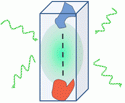Taking advantage of the additional degrees of freedom in more complex quantum systems as knobs for control, manipulation and probing give rise to exciting new possibilities but at the cost of new mechanisms for loss and decoherence. For example recent work on ultra cold KRb molecules has already revealed that the molecular gas in the quantum regime can have a surprisingly large rate of chemical reactions even in its ro-vibrational ground state. Recent experiments carried out at NIST/JILA with AEA have demonstrated significant two body decay rates in the excited clock states. The understanding of such decoherence process requires an open system formulation. Cavity-based experiments are also essentially open, as the photons leaving the cavity constantly measure the state of the system which is also disturbed by the back-action of the quantum optical noise.
The investigation of the behavior of open driven and interacting many-body systems is one of the frontiers of modern quantum physics. Those studies when carried out in the controllable and clean AMO environments and without the requirement of ultra-fast probes –as it is the case in solid state systems– can provide relevant advances in this direction.
One important thrust in our research is to help building up this knowledge. The goal is not only to understand the role of the various dissipative mechanisms but more importantly to come up with ways to take advantage of them. For example we have shown how to utilize the lossy dynamics to generate dissipation-induced entanglement and interesting many-body states.
We have also demonstrated that chemical reaction, which seem to be a fundamental limitation to explore many-body physics with polar molecules can be suppressed by the continuous quantum Zeno effect.




